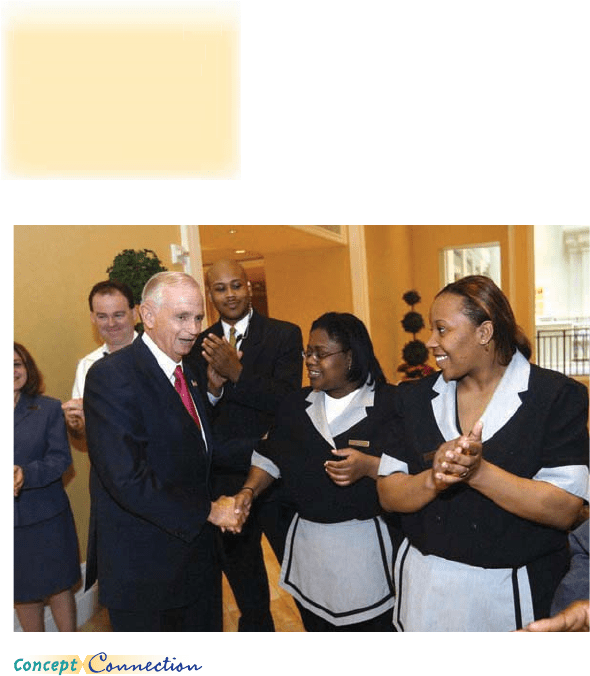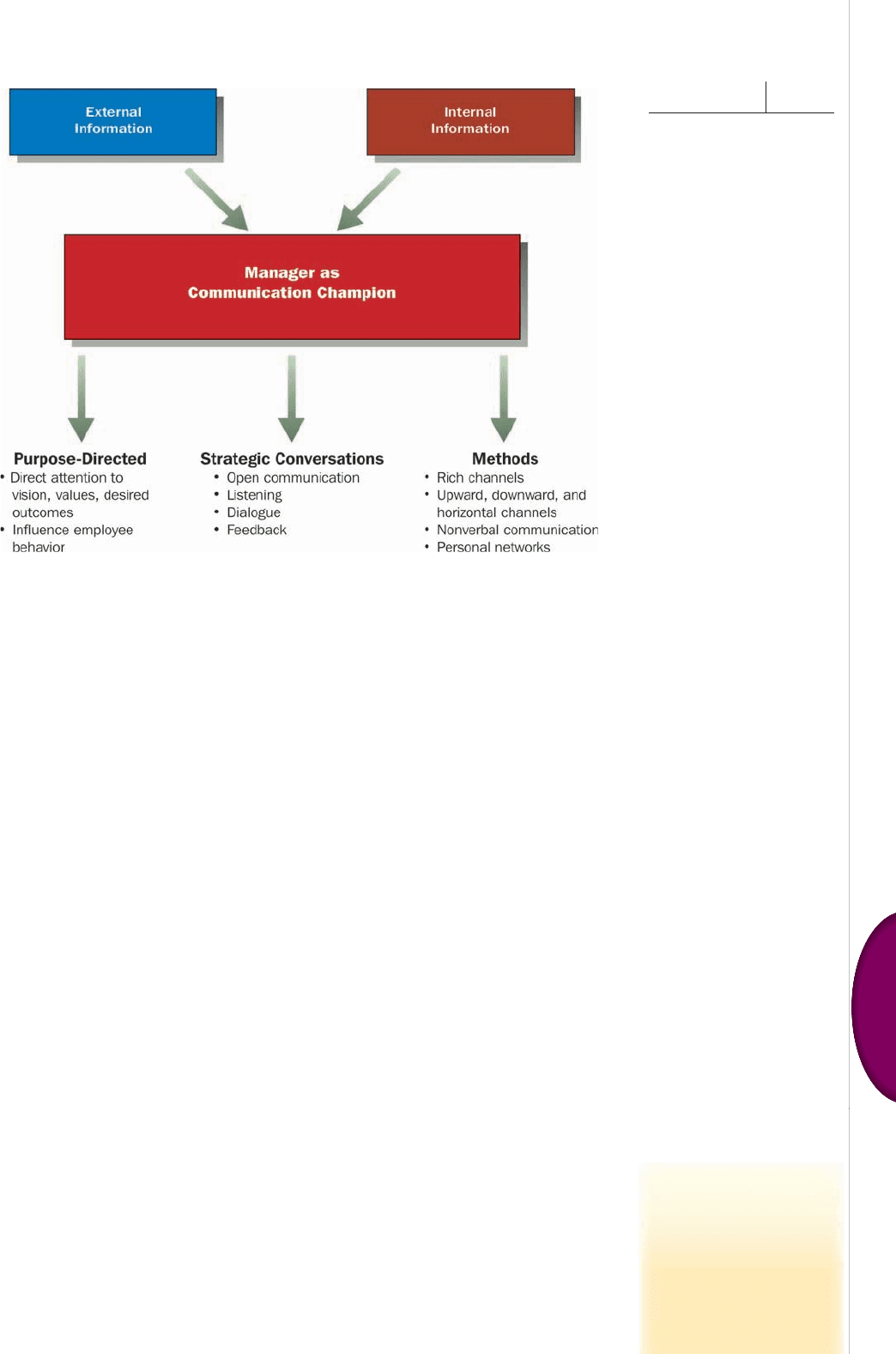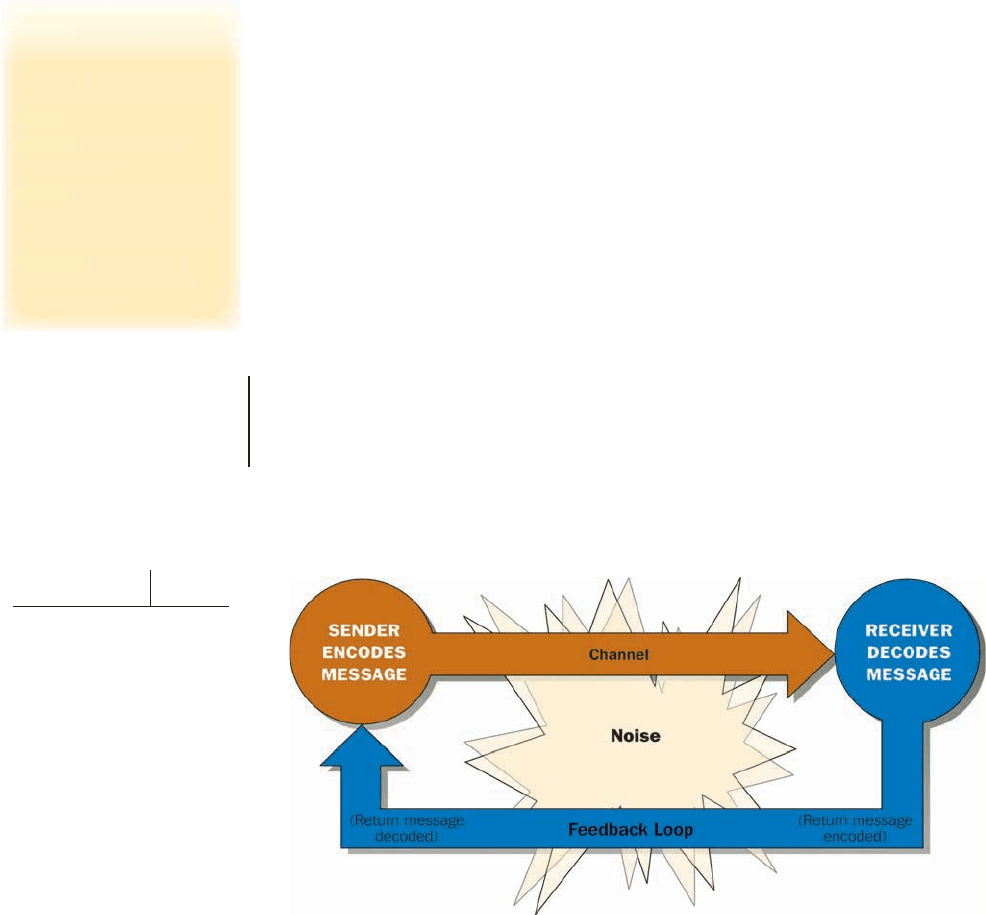Richard L. Daft - Management. 9th ed., 2010
Подождите немного. Документ загружается.


chapter16pt5
© GE T TY IMAGES/DIGITAL VISION
Chapter Outline
Learning Outcomes
After studying this chapter, you should be able to:
1. Explain why communication is essential for effective management, and
describe the communication pr
ocess.
2. Describe the concept of channel richness, and explain how communica-
tion channels infl
uence the quality of communication.
3. Understand how gender differences, nonverbal communication, and lis-
t
ening affect the effectiveness of communication.
4. Explain the difference between formal and informal organizational com-
munications and the impor
tance of each for organization management.
5. Identify how structure infl
uences team communication outcomes.
6. Appreciate the role of personal communication channels in enhancing
or
ganizational communication.
7. Recognize the manager’s role in creating dialogue, managing crisis com-
munication, of
fering feedback, and creating a climate of trust.
Are You Building a Personal Network?
Communication Is the Manager’s Job
What Is Communication?
The Communication Pr
ocess
Communicating Among People
Communication Channels
Communicating to P
ersuade and Infl uence
Others
Gender Differences in Communication
Nonverbal Communication
Listening
New Manager Self-Test: What Is Your
Social Disposition?
Organizational Communication
Formal Communication Channels
T
eam Communication Channels
Personal Communication Channels
Innovations in Organizational
Communication
Dialogue
Crisis Communication
Feedback and Learning
Climat
e of Trust and Openness

471
Managing
Communication
Controlling
6
Planning
3
Environment
2
4
Organizing
5
Leading
Introduction
1
ARE YOU BUILDING A PERSONAL NETWORK?
How much effort do you put into developing connections
with other people? Personal networks may help a new
manager in the workplace. To learn something about your
networking skills, answer the questions below. Please indi-
cate whether each item is Mostly True or Mostly False for
you in school or at work.
Mostly
True
Mostly
False
1. I learn early on about changes
going on in the organization and
how they might affect me or my
position.
2. I network as much to help other
people solve problems as to help
myself.
3. I am fascinated by other people
and what they do.
4. I frequently use lunches to meet
and network with new people.
5. I regularly participate in chari-
table causes.
6. I maintain a list of friends and
colleagues to whom I send holi-
day greeting cards.
7. I maintain contact with people
from previous organizations and
school groups.
8. I actively give information to sub-
ordinates, peers, and my boss.
SCORING AND INTERPRETATION: Give yourself
one point for each item marked as Mostly True. A score
of six or higher suggests active networking and a solid
foundation on which to begin your career as a new man-
ager. When you create a personal network, you become
well connected to get things done through a variety of
relationships. Having sources of information and sup-
port helps a new manager gain career traction. If you
scored three or less, you may want to focus more on
building relationships if you are serious about a career
as a manager. People with active networks tend to be
more effective managers and have broader impact on the
organization.
Personal networking is an important skill for managers because it enables them to get
things done more smoothly and rapidly than they could do in isolation. Networking
builds social, work, and career relationships that facilitate mutual bene t. How do
managers build a personal network that includes a broad range of professional and
social relationships? One key is knowing how to communicate effectively. In fact,
communication is a vital factor in every aspect of the manager’s job.
Organizations in today’s complex business environment depend on effective
communication to ensure business success. This is especially true in the competitive
world of retailing. Target, ranked 33rd on the Fortune 500, banks on a steady stream
of bold new product ideas to stay competitive against Wal-Mart and its low-price
strategy. Yet Target managers know employee enthusiasm and knowledge is just as
important as the products. Target educates employees with frequent communica-
tion about the company’s vision, values, and strategic goals. Before trendsetting new
products are launched in stores, for example, top managers thoroughly educate more
than 150 marketing managers, PR representatives, and even the training staff on the
marketing strategy behind each product. “We take the time to communicate to our

PART 5 LEADING472
broad organization what they do, why they’re doing it, and how it ts the whole,”
explains CEO Gregg Steinhafel.
1
Target’s managers know that effective organizational communication leads to
business success and impressive nancial gains. A study by Watson Wyatt World-
wide found that companies with the most effective communication programs had a
47 percent higher total return to shareholders from 2002 to 2006 when compared with
companies that had less effective communication.
2
Not only does effective communication lead to better bottom-line results, but
much of a manager’s time is spent communicating. Managers spend at least 80 per-
cent of every working day in direct communication with others. In other words,
48 minutes of every hour is spent in meetings, on the telephone, communicating
online, or talking informally while walking around. The other 20 percent of a typical
manager’s time is spent doing desk work, most of which is also communication in
the form of reading and writing.
3
This chapter explains why managers should make effective communication a
priority. First, we examine communication as a crucial part of the manager’s job
and describe a model of the communication process. Next, we consider the inter-
personal aspects of communication, including communication channels, persua-
sion, gender differences, listening skills, and nonverbal communication that affect
managers’ ability to communicate. Then, we look at the organization as a whole
and consider formal upward, downward, and horizontal communications as well
as personal networks and informal communications. Finally, we describe the man-
ager’s role in creating dialogue, managing crisis communication, using feedback
and learning to improve employee performance, and creating a climate of trust and
openness.
COMMUNICATION IS THE MANAGER’S JOB
Exhibit 16.1 illustrates the crucial role of managers as communication champions.
Managers gather important information from both inside and outside the organiza-
tion and then distribute appropriate infor-
mation to others who need it. Managers’
communication is purpose-directed in that
it directs everyone’s attention toward the
vision, values, and desired goals of the
team or organization and in uences people
to act in a way to achieve the goals. Man-
agers facilitate strategic conversations by
using open communication, actively lis-
tening to others, applying the practice of
dialogue, and using feedback for learning
and change. Strategic conversation refers
to people talking across boundaries and
hierarchical levels about the team or orga-
nization’s vision, critical strategic themes,
and the values that help achieve important
goals.
4
For example, at Royal Philips Elec-
tronics, president Gerald Kleisterlee de ned
four strategic technology themes that he
believes should de ne Philips’s future in
the industry: display, storage, connectivity,
and digital video processing. These themes
intentionally cross technology boundaries,
which require that people communicate
and collaborate across departments and
divisions to accomplish goals.
5
As communication champion for Marriott Interna-
tional, CEO Bill Marriott gathers information and communicates the vision, values,
and goals of the company. Here he stops to congratulate employees on the opening
of a new Renaissance Grand Hotel in downtown St. Louis. In his blog, Marriott on
the Move at www.blogs.marriott.com, the CEO opens communication with Marriott
customers and employees and shares his views on current events and how they affect
the company’s mission.
© BILL GREENBLATT/UPI /LANDOV
s
s
s
s
s
str
ateg
i
c conversat
i
on
Di
Dia
Dia
Dia
-
-
l
l
l
lo
o
o
og
ue across boundaries and
h
h
h
h
h
i
e
r
a
r
c
hi
ca
l l
e
v
e
l
s
a
bou
t
t
h
e
t
t
t
e
e
am or or
g
anization
’
s vision,
c
c
c
c
cr
r
itical strate
g
ic themes, and
t
t
t
h
h
h
e
t
va
l
ues t
h
at
h
e
l
p ac
h
ieve
i
im
im
im
m
mp
mp
im
i
ortant
g
o
g
a
l
s
.

CHAPTER 16 MANAGING COMMUNICATION 473
5
Leading
Communication permeates every management function described in Chapter 1.
6
For example, when managers perform the planning function, they gather informa-
tion; write letters, memos, and reports; and meet with other managers to formulate
the plan. When managers lead, they communicate to share a vision of what the orga-
nization can be and motivate employees to help achieve it. When managers organize,
they gather information about the state of the organization and communicate a new
structure to others. Communication skills are a fundamental part of every manage-
rial activity.
What Is Communication?
A professor at Harvard once asked a class to de ne communication by drawing pic-
tures. Most students drew a manager speaking or typing on a computer keyboard.
Some placed “speech balloons” next to their characters; others showed pages ying
from a printer. “No,” the professor told the class, “none of you has captured the
essence of communication.” He went on to explain that communication means “to
share,” not “to speak” or “to write.”
Communication is the process by which information is exchanged and under-
stood by two or more people, usually with the intent to motivate or in uence behavior.
Communication is not just sending information. Honoring this distinction between
sharing and proclaiming is crucial for successful management. A manager who does
not listen is like a used-car salesperson who claims, “I sold a car—they just did not
buy it.” Management communication is a two-way street that includes listening and
other forms of feedback. Effective communication, in the words of one expert, occurs
as follows:
When two people interact, they put themselves into each other’s shoes, try to perceive the world
as the other person perceives it, try to predict how the other will respond. Interaction involves
reciprocal role-taking, the mutual employment of empathetic skills. The goal of interaction is
EXHIBIT 16.1
The Manager as Communi-
cation Champion
SOURCES: Adapted from Henry Mintzberg, The Nature of Managerial Work (New York: Harper and Row, 1973); and
Richard L. Daft, The Leadership Experience, 3rd ed. (Cincinnati, OH: South-Western, 2005), p. 346.
c
c
c
c
c
com
m
u
ni
cat
i
o
n
The process
by
by
b
by
y
y
y
y
y
w
w
w
w
w
w
hi
w
ch information is exchan
g
e
d
d
d
a
a
a
an
nd
an
nd
a
un
un
der
der
sto
sto
od
od
by
by
two
two
or
or
mo
mo
re
e
re
e
p
p
p
p
eo
p
eo
p
ple
ple
,u
,
u
sua
sua
lly
lly
wi
wi
th
th
the
the
in
in
ten
ten
tt
t
t
o
o
o
o
o
o
m
m
m
m
mot
m
m
mot
m
iva
iva
te
te
or
or
infl
infl
ue
ue
nce
nce
be
be
hav
hav
ior
ior
.

PART 5 LEADING474
the merger of self and other, a complete ability to anticipate, predict, and behave in accordance
with the joint needs of self and other
.
7
It is the desire to share understanding that motivates executives to visit employ-
ees on the shop oor, hold small informal meetings, or eat with employees in the
company cafeteria. The information that managers gather from direct communication
with employees shapes their understanding of the organization.
The Communication Process
Many people think communication is simple. After all, we communicate every day
without even thinking about it. However, communication usually is complex, and
the opportunities for sending or receiving the wrong messages are innumerable. No
doubt, you have heard someone say, “But that’s not what I meant!” Have you ever
received directions you thought were clear and yet still got lost? How often have you
wasted time on misunderstood instructions?
To better understand the complexity of the communication process, note the key
elements outlined in Exhibit 16.2. Two essential elements in every communication
situation are the sender and the receiver. The sender is anyone who wishes to convey
an idea or concept to others, to seek information, or to express a thought or emotion.
The receiver is the person to whom the message is sent. The sender encodes the idea
by selecting symbols with which to compose a message. The message is the tangible
formulation of the idea that is sent to the receiver. The message is sent through a
channel, which is the communication carrier. The channel can be a formal report, a
telephone call, an e-mail message, or a face-to-face meeting. The receiver decodes
the symbols to interpret the meaning of the message. Encoding and decoding are
potential sources for communication errors, because knowledge, attitudes, and back-
ground act as lters and create noise when translating from symbols to meaning.
Finally,
feedback occurs when the receiver responds to the sender’s communica-
tion with a return message. Without feedback, the communication is one-way; with
feedback, it is two-way. Feedback is a powerful aid to communication effectiveness,
because it enables the sender to determine whether the receiver correctly interpreted
the message.
As a new manager, become a communication champion by communicating across
boundaries, actively listening to others, and using feedback to make improvements.
Remember that effective communication requires sharing and achieving mutual
understanding.
TakeaMoment
EXHIBIT 16.2
A Model of the
Communication Process
e
e
e
e
e
enc
o
d
e T
o
o
se
l
se
ect
ect
sy
sy
m
bo
bo
l
s
s
wit
t
t
h
h
h
h
h
h
w
w
w
w
hi
w
w
whi
w
w
w
h
c
h
t
t
o com
p
os
p
e a messa
g
e.
g
m
m
m
m
m
essage The tangible formu
-
-
l
l
la
a
a
at
i
o
n
o
f
a
n i
dea
to
be
se
n
t
t
o
a
a
r
r
r
r
re
ec
ei
v
e
r
.
c
c
c
ch
anne
l
Th
e carrier o
f
a
c
c
c
c
co
o
mmun
i
cat
i
on
.
d
d
d
d
eco
d
e
T
o trans
l
ate t
h
e s
y
m
b
o
l
ls
s
s
s
u
u
u
u
u
se
d
in a message
f
or t
h
e pur
-
p
p
p
p
p
ose o
f
interpreting its meanin
g
g.
.
f
f
f
f
fee
dbac
k
A
response b
y
t
t
t
h
h
he
t
r
ece
iv
e
r
to
t
h
e
se
n
de
r’
s
c
c
c
c
co
co
o
o
c
mmu
m
ni
cat
i
o
n
.

CHAPTER 16 MANAGING COMMUNICATION 475
5
Leading
COMMUNICATING AMONG PEOPLE
The communication model in Exhibit 16.2 illustrates the components of effective com-
munication. Communications can break down if sender and receiver do not encode
or decode language in the same way.
8
We all know how dif cult it is to communicate
with someone who does not speak our language, and today’s managers are often
trying to communicate with people who speak many different native languages. The
Manager’s Shoptalk offers suggestions for communicating effectively with people
who speak a different language.
In today’s global business environment, odds are good
you’ll nd yourself conversing with an employee,
colleague, or customer who has limited skills in your
native language. Here are some guidelines that will
help you speak—and listen—more effectively.
1. Keep your message simple. Be clear about what
you want to communicate, and keep to the
point. Avoid slang. Using too many culturally
narrow expressions, idioms, colloquialisms, and
too much humor can cause your message to be
totally lost in translation.
2. Select your words with care. Don’t try to dazzle
with your vocabulary. Choose simple words,
and look for opportunities to use cognates—that
is, words that resemble words in your listener’s
language. For example, banco in Spanish means
“bank” in English. Assemble those simple words
into equally simple phrases and short sentences.
And be sure to avoid idioms, slang, jargon, and
vague terminology such as soon, often, or several.
3. Pay close attention to nonverbal messages.
Don’t cover your mouth with your hand. Being
able to see your lips helps your listener decipher
what you are saying.
4. Speak slowly and carefully. In particular, avoid
running words together. “Howyadoin?” won’t
make any sense to someone still struggling with
the English language, for example.
5. Allow for pauses. If you’re an American, your
culture has taught you to avoid silence when-
ever possible. However, pauses give your lis-
tener time to take in what you have said, ask a
question, or formulate a response.
6. Fight the urge to shout. Speaking louder doesn’t
make it any easier for someone to understand
you. It also tends to be intimidating and could
give the impression that you are angry.
7. Pay attention to facial expressions and body
language, but keep in mind that the meaning of
such cues can vary signi cantly from culture to
culture. For example, Americans may view eye
contact as a sign you’re giving someone your full
attention, but the Japanese consider prolonged
eye contact rude.
8. Check for comprehension frequently, and invite
feedback. Stop from time to time and make sure
you’re being understood, especially if the other
person laughs inappropriately, never asks a
question, or continually nods and smiles politely.
Ask the listener to repeat what you’ve said in his
or her own words. If you nd the other person
hasn’t understood you, restate the information
in a different way instead of simply repeating
yourself. Similarly, listen carefully when the
non-native speaks, and offer feedback so the per-
son can check your understanding of his or her
message.
Effective multicultural communication isn’t easy,
but a small investment in clear communication will
result in trust and improved productivity.
SOURCES: Marshall Goldsmith, “Crossing the Cultural
Chasm,” BusinessWeek.com, May 30, 2007, http://www
.businessweek.com/careers/content/may2007/ca20070530_
521679.htm?chan=search (accessed April 8, 2008); “How to
Communicate with a Non Native English Speaker,” wikiHow,
www.wikihow.com/ Communicate-With-a-Non-Native-
English-Speaker; Sondra Thiederman, “Language Barriers:
Bridging the Gap,” www.thiederman.com/articles_detail
.php?id=39; and “Communicating with Non-native Speakers,”
Magellan Health Services, www.magellanassist.com/mem/
library/default.asp?TopicId=95&CategoryId=0&ArticleId=5.
Breaking Down Language Barriers
Manager’sShoptalk

PART 5 LEADING476
Many factors can lead to a breakdown in communications. For example, the selec-
tion of communication channel can determine whether the message is distorted by
noise and interference. The listening skills of both parties and attention to nonverbal
behavior can determine whether a message is truly shared. Thus, for managers to be
effective communicators, they must understand how factors such as communication
channels, the ability to persuade, gender differences, nonverbal behavior, and listen-
ing all work to enhance or detract from communication.
Communication Channels
Managers have a choice of many channels through which to communicate to other man-
agers or employees. A manager may discuss a problem face-to-face, make a telephone
call, use instant messaging, send an e-mail, write a memo or letter, or post an entry
to a company blog, depending on the nature of the message. Research has attempted
to explain how managers select communication channels to enhance communication
effectiveness.
9
The research has found that channels differ in their capacity to convey
information. Just as a pipeline’s physical characteristics limit the kind and amount of liq-
uid that can be pumped through it, a communication channel’s physical characteristics
limit the kind and amount of information that can be conveyed through it. The channels
available to managers can be classi ed into a hierarchy based on information richness.
The Hierarchy of Channel Rich-
ness Channel richness is the amount of
information that can be transmitted during
a communication episode. The hierarchy of
channel richness is illustrated in Exhibit 16.3.
The capacity of an information channel is
in uenced by three characteristics: (1) the
ability to handle multiple cues simultane-
ously; (2) the ability to facilitate rapid, two-
way feedback; and (3) the ability to establish
a personal focus for the communication.
Face-to-face discussion is the richest medium,
because it permits direct experience, mul-
tiple information cues, immediate feedback,
and personal focus. Face-to-face discussions
facilitate the assimilation of broad cues and
deep, emotional understanding of the situ-
ation. Telephone conversations are next in
the richness hierarchy. Although eye contact,
posture, and other body language cues are
missing, the human voice can still carry a tre-
mendous amount of emotional information.
Electronic messaging, such as e-mail
and instant messaging, is increasingly being
used for messages that were once handled
via the telephone. However, in a survey
by researchers at The Ohio State University, most respondents said they preferred
the telephone or face-to-face conversation for communicating dif cult news, giving
advice, or expressing affection.
10
Because e-mail messages lack both visual and verbal
cues and don’t allow for interaction and feedback, messages can sometimes be mis-
understood. Using e-mail to discuss disputes, for example, can lead to an escalation
rather than a resolution of con ict.
11
Studies have found that e-mail messages tend to be
much more blunt than other forms of communication, even other written communica-
tions. This bluntness can cause real problems when communicating cross-culturally,
because some cultures consider directness rude or insulting.
12
Instant messaging
Videoconferencing systems, such as the Polycom high-
defi nition system shown here, use increasingly sophisticated hardware and software
to transmit both visual and verbal cues and provide feedback. On large screens in
the front of the room, managers not only see and hear colleagues thousands of
miles away, but they can also scrutinize displays of relevant information. These new
systems provide channel richness once characteristic of only face-to-face meetings.
Analysts expect that terrorism threats, possible pandemics, and expensive business
travel will fuel at least a 20 percent annual increase in spending on videoconferenc-
ing systems in the foreseeable future.
© POLYCOM, INC./PR NEWSWIRE PHOTO SERVICE
c
c
c
c
c
cha
nnel richness
Th
The
The
am
am
oun
n
n
oun
n
t
t
t
t
t
t
t
t
t
o
o
o
o
o
of
f
information that can be trans
-
-
-
-
m
m
m
m
m
m
itted during a communicatio
n
n
e
e
e
e
ep
p
isode
.

CHAPTER 16 MANAGING COMMUNICATION 477
5
Leading
alleviates the problem of miscommunication to some extent by allowing for imme-
diate feedback. Instant messaging (IM) allows users to see who is connected to a
network and share short-hand messages or documents with them instantly. A grow-
ing number of managers are using IM, indicating that it helps people get responses
faster and collaborate more smoothly.
13
Overreliance on e-mail and IM can damage
company communications because people stop talking to one another in a rich way
that builds solid interpersonal relationships. However, some research indicates that
electronic messaging can enable reasonably rich communication if the technology
is used appropriately.
14
Organizations are also using videoconferencing that offers
video capabilities to provide visual cues and greater channel richness.
Still lower on the hierarchy of channel richness are written letters and memos. Writ-
ten communication can be personally focused, but it conveys only the cues written on
paper and is slower to provide feedback. Impersonal written media, including iers, bul-
letins, and standard computer reports, are the lowest in richness. These channels are not
focused on a single receiver, use limited information cues, and do not permit feedback.
Selecting the Appropriate Channel It is important for managers to understand
that each communication channel has advantages and disadvantages and that each
can be an effective means of communication in the appropriate circumstances.
15
Chan-
nel selection depends on whether the message is routine or nonroutine. Nonroutine
messages typically are ambiguous, concern novel events, and involve great potential
for misunderstanding. They often are characterized by time pressure and surprise.
Managers can communicate nonroutine messages effectively by selecting rich chan-
nels. Routine messages are simple and straightforward. They convey data or statistics
or simply put into words what managers already agree on and understand. Routine
messages can be ef ciently communicated through a channel lower in richness, such
as e-mail. Written communications should also be used when the communication is
of cial and a permanent record is required.
16
As a new manager, take care in choosing how to send a message. Don’t use e-mail
for diffi cult or emotional conversations that should be dealt with face-to-face or by
telephone. E-mail is preferable for routine communications.
Consider the alert to consumers issued by the FDA following a widespread
E.coli outbreak in September 2006. Tainted bagged spinach sickened 199 people in
at least 26 states and resulted in one death. Grocers immediately pulled the prod-
uct from shelves, and widespread news coverage warned the public not to consume
any bagged spinach until the cause of the contamination could be identi ed. An
TakeaMoment
High
Channel Richness
Low
Channel Richness
Face-to-face
Communication
Reports/Bulletins
Letters and Memos
Advantages
Personal
Two-way
Fast feedback
Advantages
Permanent record
Premeditated
Easy to
disseminate
Disadvantages
No permanent record
Spontaneous
Difficult to
disseminate
Disadvantages
Impersonal
One-way
Slow feedback
Telephone
Electronic Messages
(email, IM, blogs)
EXHIBIT 16.3 A Continuum of Channel Richness
i
i
i
i
in
in
ins
tant messaging
(
IM
)
E
E
E
E
E
E
le
E
ctronic communication tha
t
t
a
a
a
al
ll
al
ll
a
ows
ows
us
us
ers
ers
to
to
se
se
ew
e
w
ho
ho
is
is
con
con
-
-
n
n
n
n
n
nec
n
nec
ted
ted
to
to
a
a
net
net
wor
wor
ka
k
a
nd
nd
sha
sha
re
re
i
i
in
n
nf
i
i
n
nf
n
orm
orm
ati
ati
on
on
ins
ins
tan
tan
tly
tly
.

PART 5 LEADING478
immediate response was critical. This type of nonroutine communication forces a
rich information exchange. The group facing such a communication challenge will
meet face-to-face, brainstorm ideas, and provide rapid feedback to resolve the situa-
tion and convey the correct information. If, in contrast, an agency director is prepar-
ing a press release about a routine matter such as a policy change or new department
members, less information capacity is needed. The director and public relations peo-
ple might begin developing the press release with an exchange of memos, telephone
calls, and e-mail messages.
The key is to select a channel to t the message. During a major acquisition, one
rm decided to send top executives to all major work sites of the acquired company,
where most of the workers met the managers in person, heard about their plans for
the company, and had a chance to ask questions. The results were well worth the time
and expense of the personal face-to-face meetings because the acquired workforce
saw their new managers as understanding, open, and willing to listen.
17
Communi-
cating their nonroutine message about the acquisition in person prevented damaging
rumors and misunderstandings. The choice of a communication channel can also
convey a symbolic meaning to the receiver; in a sense, the medium becomes the mes-
sage. The rm’s decision to communicate face-to-face with the acquired workforce
signaled to employees that managers cared about them as individuals.
Communicating to Persuade and Infl uence Others
Communication is not just for conveying information, but also to persuade and
in uence people. Although communication skills have always been important to
managers, the ability to persuade and in uence others is even more critical today.
Businesses are run largely by cross-functional teams that are actively involved in
making decisions. Issuing directives is no longer an appropriate or effective way to
get things done.
18
To persuade and in uence, managers have to communicate frequently and eas-
ily with others. Yet some people nd interpersonal communication experiences
unrewarding or dif cult and thus tend to avoid situations where communication is
required. The term communication apprehension describes this avoidance behavior
and is de ned as “an individual’s level of fear or anxiety associated with either real
or anticipated communication.” With training and practice, managers can overcome
their communication apprehension and become more effective communicators.
Go to the experiential exercise on pages 494–495 that pertains to your level of
communication apprehension.
Effective persuasion doesn’t mean telling people what you want them to do;
instead, it involves listening, learning about others’ interests and needs, and lead-
ing people to a shared solution.
19
Managers who forget that communication means
sharing, as described earlier, aren’t likely to be as effective at in uencing or persuad-
ing others, as the founder and president of the executive coaching rm Valuedance
learned the hard way.
When Susan Cramm was asked by a client to help persuade the client’s boss to support an
initiative she wanted to launch, Cramm readily agreed. They scheduled a meeting with the
boss, then held a series of planning sessions where the two discussed the current situation at
the client’s fi rm, weighed the options, and decided on the best approach for launching the
initiative. Filled with enthusiasm and armed with a PowerPoint presentation, Cramm was
sure the client’s boss would see things their way.
An agonizing 15 minutes later, she was out the door, PowerPoint deck and all, hav-
ing just had a lesson about the art of persuasion. What went wrong? Cramm had focused
on the hard, rational matters and ignored the soft skills of relationship building, listening,
and negotiating that are so crucial to persuading others. “Never did we consider the boss’s
TakeaMoment
Valuedance
Innovative Way
c
c
c
c
c
com
munication apprehen-
s
s
s
sio
n
A
n individual’s level o
f
f
f
f
f
fe
e
e
ar or anxiety associated with
i
i
i
in
in
n
nt
nt
i
erp
p
ersonal communicat
ion
n
s
s.
s.
.

CHAPTER 16 MANAGING COMMUNICATION 479
5
Leading
views,” Cramm said later about the planning sessions she and her client held to prepare for
the meeting. “Like founding members of the ‘it’s all about me’ club, we fell upon our swords,
believing that our impeccable logic, persistence, and enthusiasm would carry the day.”
With that approach, the meeting was over before it even began. The formal presentation
shut down communications because it implied that Cramm had all the answers and the boss
was just there to listen and agree.
20
As this example shows, people stop listening to someone when that individual
isn’t listening to them. By failing to show interest in and respect for the boss’s point
of view, Cramm and her client lost the boss’s interest from the beginning, no matter
how suitable the ideas they were presenting. To effectively in uence and persuade
others, managers have to show they care about how the other person feels. Persua-
sion requires tapping into people’s emotions, which can only be done on a personal,
rather than a rational, impersonal level.
Gender Differences in Communication
As a new manager, you will undoubtedly encounter a vari-
ety of different communication styles in the workplace.
Class, race, ethnicity, and gender are all factors that in u-
ence how people communicate. Managers should work hard
to shed any innate or rigid opinions about a person’s com-
munication style so these beliefs don’t hinder understand-
ing or adversely affect personnel decisions, such as hiring
or promoting. It is much more productive to recognize and
appreciate differences in communication styles, thereby
reducing some of the problems that naturally occur when
a sender and receiver do not encode or decode language in
the same way.
One difference managers encounter frequently relates to
gender. How does gender affect communication style? For
most women, although certainly not all, talking means con-
versation and is primarily a language of rapport, a way to
establish connections and negotiate relationships. Women
use their unique conversational style to show involvement,
connection, and participation, such as by seeking similarities
and matching experiences with others. They tend to inter-
rupt less than men do and work hard to keep a conversation
going. For most men, on the other hand, talk is primarily a
means to preserve independence and negotiate and main-
tain status in a hierarchy. Men tend to use verbal language to exhibit knowledge and
skill, such as by telling stories, joking, or passing on information.
21
Another notable
difference related to communication in the workplace is how women and men claim
credit for work accomplished. Because women typically seek to build rapport, they
are inclined to downplay their expertise and accomplishments rather than display
them. Men, on the other hand, tend to value their position at center stage, enjoy dem-
onstrating their knowledge, and more easily take credit for their accomplishments.
22
When managers understand this gender difference, they can make an extra effort to
encourage women to take credit when it is deserved.
Women and men also display differences in body language. Women tend to use
more submissive gestures when communicating with men: using less body space,
pulling in their body, tilting their heads while talking or listening, putting their hands
in their laps more often, and lowering their eyes. Men tend to stare more, point more,
take up more space, keep their heads straight, sit in a more outstretched position, and
use larger, more sweeping gestures.
23
Grasping the different communication styles of
men and women may help managers maximize every employee’s talents and encour-
age both men and women to contribute more fully to the organization.
© BOB DAEMMRICH/THE IMAGE WORKS
Rosa and Jorrick Battles, a suc-
cessful entrepreneurial couple, manage gender differences in
communication to plan their schedules and run their business.
Women tend to build rapport and relationships in their commu-
nications by sharing information. Men tend to negotiate hierarchy
and gather information to make decisions. Researchers show
that women typically read more nonverbal cues to enrich their
understanding. They also use questions that solicit participation.
These differences can enhance or hinder communications in the
workplace and in personal experiences. Communication problems
send couples into therapy more than any other relationship issue.
